Reply to Skorik's Comment
英文投稿进程中的十种状态
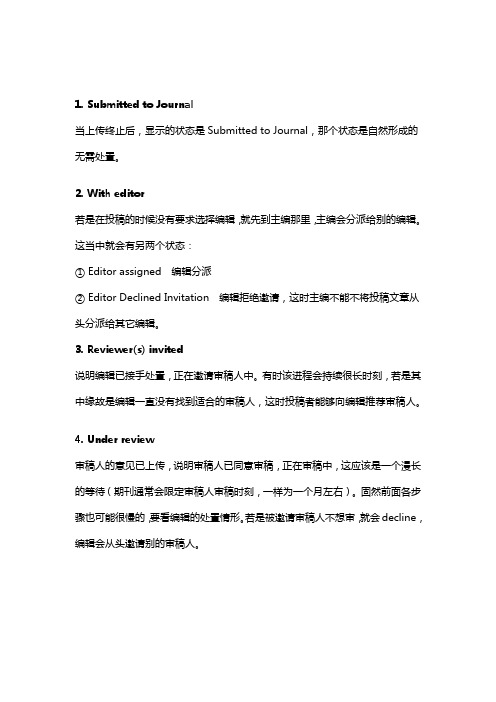
1. Submitted to Journal当上传终止后,显示的状态是Submitted to Journal,那个状态是自然形成的无需处置。
2. With editor若是在投稿的时候没有要求选择编辑,就先到主编那里,主编会分派给别的编辑。
这当中就会有另两个状态:① Editor assigned编辑分派② Editor Declined Invitation编辑拒绝邀请,这时主编不能不将投稿文章从头分派给其它编辑。
3. Reviewer(s) invited说明编辑已接手处置,正在邀请审稿人中。
有时该进程会持续很长时刻,若是其中缘故是编辑一直没有找到适合的审稿人,这时投稿者能够向编辑推荐审稿人。
4. Under review审稿人的意见已上传,说明审稿人已同意审稿,正在审稿中,这应该是一个漫长的等待(期刊通常会限定审稿人审稿时刻,一样为一个月左右)。
固然前面各步骤也可能很慢的,要看编辑的处置情形。
若是被邀请审稿人不想审,就会decline,编辑会从头邀请别的审稿人。
5. required review completed审稿终止,等编辑处置,该进程短那么几天,长那么无期,有一篇文章显现required review completed状态已近一个月了,仍是没有消息。
6. Decision in Process到了这一步就快要有结果了,编辑开始考虑是给修改仍是直接拒,固然也有可能直接同意的,但可能性很小,呵呵。
7. Minor revision/Major revision小修/大修,那个时候能够略微庆贺一下了,因为有修改就有可能。
具体怎么改就不多说了,谦虚谨慎是不可少的(因为修改后一样会再发给审稿人看,因此必然要细心的回答每一个审稿人的每一个问题,态度要谦逊,要让审稿人感觉他提的每一个问题都很有水准的,然后针对他的问题,一个一个的做出回答,能修改的就修改,不能修改的给出理由,而且都要列出来,文章的哪一段哪一行修改了最好都说出来,记住:给审稿人减少麻烦确实是给你自己减少麻烦!另注:有时,审稿人会在修改意见里隐讳里说出要你认真阅读某几篇文献,这时可要注意了,其中某些文章可能确实是评审者自己发表的,这时你最好在你的修改稿中加以引用),修改后被拒绝的例子也多不胜数的。
英文 回复审稿人意见

回复审稿人意见开头The authors want to really thank the editor for the time spent reviewing the manuscript and for his valuable comments and suggestions. According to his valuable recommendations, we modified the manuscript.The authors want to really thank the reviewer for the time spent reviewing the manuscript and for his valuable comments and suggestions. According to his valuable recommendations, we modified the manuscript as reported in the point-by-point responses below.最后一段Therefore, the whole paper was totally revised based on your suggestion and the reviewer comments. We hope that in this new version the manuscript can be considered for publication in International Journal of Mechanical Sciences.通用创新性…… have been revised to better clarify the proposed novelty.补充材料The authors want to thank the reviewer for this suggestion. Accordingly, a new sentence was added in the abstract of the new version of the manuscript for pointing out such aspects as follows:The comparison between the proposed methodology and the existing ones is presented in the introduction section but it will be treated more in detail.However, to state clearly this aspect for readers, in accordance with the reviewer’s comment, the following sentence is added to the paper:疏忽或表达不清道歉Thanks for your comment and sorry for the ambiguous expression.Thanks for your thoughtful comment and sorry for the unclear statements.回答开头一句话,承认,感谢It is a very good question.It is a very important comment and is very useful for us to improve our manuscript.This comment is highly appreciated.This comment is accepted.This comment is accepted and is very important for us to improve our manuscript.This comment is highly appreciated. We have checked the readability of the manuscript throughout, and revised accordingly, to eliminate long sentences hard to follow and odd expressions.This comment is highly appreciated. As the comment pointed out,错误纠正The authors want to thank the reviewer for highlighting such a mistake.Thank you for pointing out this problem. It is indeed that…The authors want to thank the reviewer for highlighting this very important aspect.虽然不是,但也作出了修改和完善However, to state clearly this aspect for readers, in accordance with the reviewer’s comment, the following sentence is added to the paper:删除某部分After careful consideration, we think He/She is right and we removed Fig. 11 and related discussion in the revised manuscript, and we believe this will not affect the integrity and main conclusions of the paper.感谢肯定和承认Thank you for your recognition for our work, and we sincerely appreciate your comments, which are of great importance to the improvement of our manuscript.无法补充或解释的答复This comment was highly appreciated. As the comment pointed out, how does the lubricating properties of … be improved was not explained clearly. The mechanism for improving the tribological performance of composites added with … reported in other literatures is added in introduction. As the main purpose of this paper is to discuss the synthesis of …, we did not discuss the problem in detail.As the main purpose of this paper is to discuss the synthesis of …, we think it is not necessary to present detailed mechanical analyses. Of course, the mechanical properties of …. will be studied in detail in our further works according to your valuable suggestion.As the comment pointed out, the fracture toughness in … increases and flexural strength decreases in this study. To be honest, the reason for this phenomenon is not clearly now. According to our knowledge, the fracture toughness and flexural strength do not relate with each other in some studies as well, such as doi:10.1016…., doi:10.1016/….and doi:10.1016/…., et al. But we will focus on this unusual phenomenon and try to find the reasons. Thanks again for your thoughtful comment.The questions you mentioned are of great importance to our research, and are the focus of our future research. We think again for your meaningful comments.。
回复审稿意见的礼貌用语英语
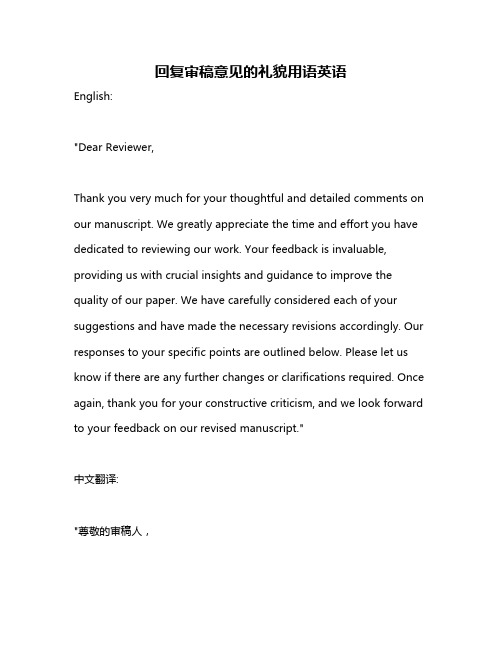
回复审稿意见的礼貌用语英语English:"Dear Reviewer,Thank you very much for your thoughtful and detailed comments on our manuscript. We greatly appreciate the time and effort you have dedicated to reviewing our work. Your feedback is invaluable, providing us with crucial insights and guidance to improve the quality of our paper. We have carefully considered each of your suggestions and have made the necessary revisions accordingly. Our responses to your specific points are outlined below. Please let us know if there are any further changes or clarifications required. Once again, thank you for your constructive criticism, and we look forward to your feedback on our revised manuscript."中文翻译:"尊敬的审稿人,非常感谢您对我们稿件的深思熟虑和详细的评论。
我们非常感激您为审阅我们的工作所投入的时间和精力。
您的反馈非常宝贵,为我们提供了重要的见解和指导,帮助我们提高论文的质量。
我们已经仔细考虑了您提出的每一条建议,并进行了相应的修改。
如何回复SCI投稿审稿人意见
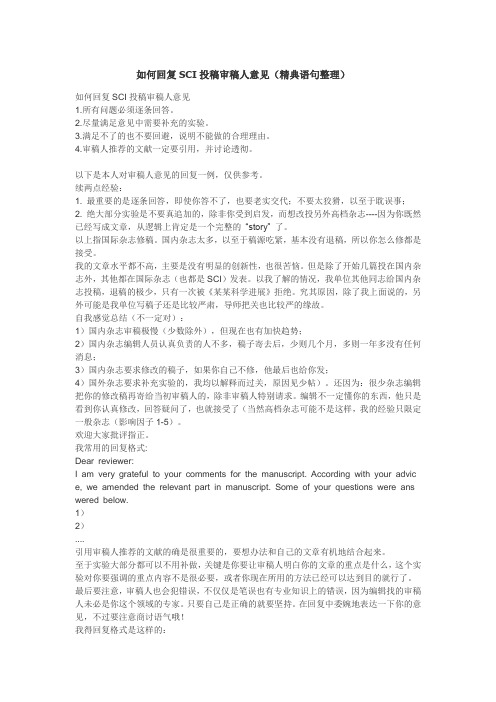
如何回复SCI投稿审稿人意见(精典语句整理)如何回复SCI投稿审稿人意见1.所有问题必须逐条回答。
2.尽量满足意见中需要补充的实验。
3.满足不了的也不要回避,说明不能做的合理理由。
4.审稿人推荐的文献一定要引用,并讨论透彻。
以下是本人对审稿人意见的回复一例,仅供参考。
续两点经验:1. 最重要的是逐条回答,即使你答不了,也要老实交代;不要太狡猾,以至于耽误事;2. 绝大部分实验是不要真追加的,除非你受到启发,而想改投另外高档杂志----因为你既然已经写成文章,从逻辑上肯定是一个完整的“story” 了。
以上指国际杂志修稿。
国内杂志太多,以至于稿源吃紧,基本没有退稿,所以你怎么修都是接受。
我的文章水平都不高,主要是没有明显的创新性,也很苦恼。
但是除了开始几篇投在国内杂志外,其他都在国际杂志(也都是SCI)发表。
以我了解的情况,我单位其他同志给国内杂志投稿,退稿的极少,只有一次被《某某科学进展》拒绝。
究其原因,除了我上面说的,另外可能是我单位写稿子还是比较严肃,导师把关也比较严的缘故。
自我感觉总结(不一定对):1)国内杂志审稿极慢(少数除外),但现在也有加快趋势;2)国内杂志编辑人员认真负责的人不多,稿子寄去后,少则几个月,多则一年多没有任何消息;3)国内杂志要求修改的稿子,如果你自己不修,他最后也给你发;4)国外杂志要求补充实验的,我均以解释而过关,原因见少帖)。
还因为:很少杂志编辑把你的修改稿再寄给当初审稿人的,除非审稿人特别请求。
编辑不一定懂你的东西,他只是看到你认真修改,回答疑问了,也就接受了(当然高档杂志可能不是这样,我的经验只限定一般杂志(影响因子1-5)。
欢迎大家批评指正。
我常用的回复格式:Dear reviewer:I am very grateful to your comments for the manuscript. According with your advic e, we amended the relevant part in manuscript. Some of your questions were ans wered below.1)2)....引用审稿人推荐的文献的确是很重要的,要想办法和自己的文章有机地结合起来。
用英文巧妙回复SCI期刊编辑信件
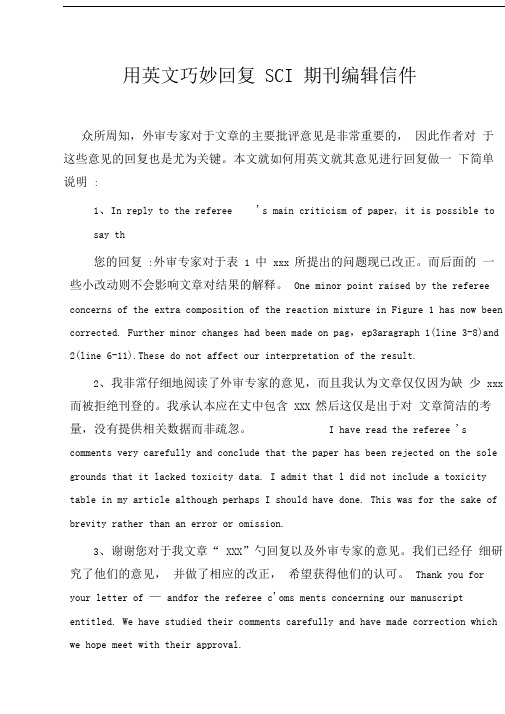
用英文巧妙回复 SCI 期刊编辑信件众所周知,外审专家对于文章的主要批评意见是非常重要的,因此作者对于这些意见的回复也是尤为关键。
本文就如何用英文就其意见进行回复做一下简单说明:1、In reply to the referee 's main criticism of paper, it is possible tosay th您的回复:外审专家对于表 1 中xxx 所提出的问题现已改正。
而后面的一些小改动则不会影响文章对结果的解释。
One minor point raised by the referee concerns of the extra composition of the reaction mixture in Figure 1 has now been corrected. Further minor changes had been made on pag,ep3aragraph 1(line 3-8)and 2(line 6-11).These do not affect our interpretation of the result.2、我非常仔细地阅读了外审专家的意见,而且我认为文章仅仅因为缺少xxx 而被拒绝刊登的。
我承认本应在丈中包含XXX 然后这仅是出于对文章简洁的考量,没有提供相关数据而非疏忽。
I have read the referee 's comments very carefully and conclude that the paper has been rejected on the sole grounds that it lacked toxicity data. I admit that l did not include a toxicity table in my article although perhaps I should have done. This was for the sake of brevity rather than an error or omission.3、谢谢您对于我文章“ XXX”勺回复以及外审专家的意见。
replytosb还是replysb

reply to sb还是reply sb
1、回答某人一般要用reply to sb。
2、使用场合不同:reply to sb是以别人为第一人称;reply sb是以自己为第一人称。
3.含义不同:reply to sb,释义:明确的答复某人;reply sb,直接回答某人。
用法不同
1.reply to sb
用法:reply to sb是被动的,表示做某事给某人,或者是某人是动作的承受者,reply与介词to连用时接that引导的宾语从句,有时也可引出直接引语。
2.reply sb
用法:基本意思是“回答”“答复”“作答”,主要指用语言文字对问题、指控、辩论、质问、起诉或致意等给予回答,也可指用行动回答,是较为正式的书面用语。
英文回复审稿人意见模板
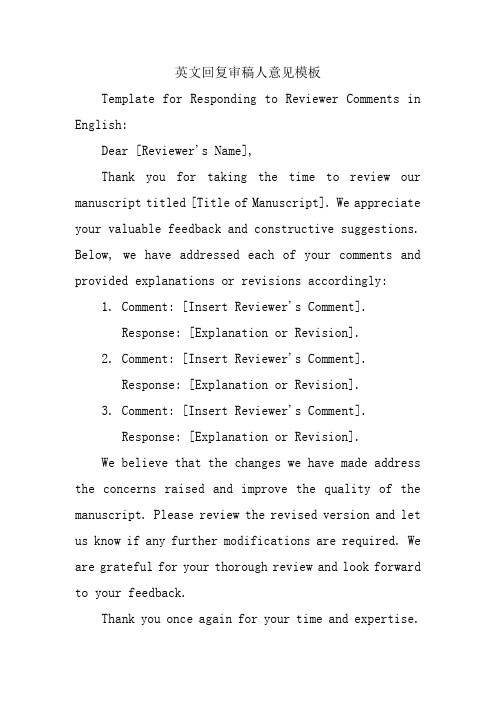
英文回复审稿人意见模板Template for Responding to Reviewer Comments in English:Dear [Reviewer's Name],Thank you for taking the time to review our manuscript titled [Title of Manuscript]. We appreciate your valuable feedback and constructive suggestions. Below, we have addressed each of your comments and provided explanations or revisions accordingly:1. Comment: [Insert Reviewer's Comment].Response: [Explanation or Revision].2. Comment: [Insert Reviewer's Comment].Response: [Explanation or Revision].3. Comment: [Insert Reviewer's Comment].Response: [Explanation or Revision].We believe that the changes we have made address the concerns raised and improve the quality of the manuscript. Please review the revised version and let us know if any further modifications are required. We are grateful for your thorough review and look forward to your feedback.Thank you once again for your time and expertise.Sincerely,[Your Name].[Your Affiliation].英文审稿人意见回复模板:尊敬的[审稿人姓名],感谢您抽出时间审阅我们的稿件《[稿件标题]》。
用英文巧妙回复SCI期刊编辑信件

用英文巧妙回复S C I期刊编辑信件Company number:【0089WT-8898YT-W8CCB-BUUT-202108】用英文巧妙回复S C I期刊编辑信件众所周知,外审专家对于文章的主要批评意见是非常重要的,因此作者对于这些意见的回复也是尤为关键。
本文就如何用英文就其意见进行回复做一下简单说明:1、In reply to the referee’s main criticism of paper, it is possible to say that您的回复:外审专家对于表1中xxx所提出的问题现已改正。
而后面的一些小改动则不会影响文章对结果的解释。
One minor point raised by the referee concerns of the extra composition of the reaction mixture inFigure 1 has now been corrected. Further minor changes had been made on page 3,paragraph 1(line 3-8)and 2(line 6-11).These do not affect ourinterpretation of the result.2、我非常仔细地阅读了外审专家的意见,而且我认为文章仅仅因为缺少xxx而被拒绝刊登的。
我承认本应在丈中包含XXX 然后这仅是出于对文章简洁的考量,没有提供相关数据而非疏忽。
I have read thereferee’s comments very carefully and conclude that the paper has beenrejected on the sole grounds that it lacked toxicity data. I admit that l did not include a toxicity table in my article although perhaps I should have done.This was for the sake of brevity rather than an error or omission.3、谢谢您对于我文章“XXX”的回复以及外审专家的意见。
审稿意见回稿用语
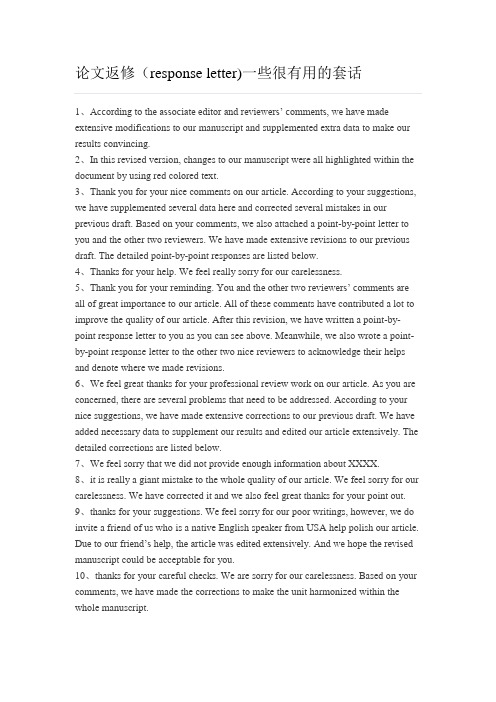
论文返修(response letter)一些很有用的套话1、According to the associate editor and reviewers’ comments, we have made extensive modifications to our manuscript and supplemented extra data to make our results convincing.2、In this revised version, changes to our manuscript were all highlighted within the document by using red colored text.3、Thank you for your nice comments on our article. According to your suggestions, we have supplemented several data here and corrected several mistakes in our previous draft. Based on your comments, we also attached a point-by-point letter to you and the other two reviewers. We have made extensive revisions to our previous draft. The detailed point-by-point responses are listed below.4、Thanks for your help. We feel really sorry for our carelessness.5、Thank you for your reminding. You and the other two reviewers’ comments are all of great importance to our article. All of these comments have contributed a lot to improve the quality of our article. After this revision, we have written a point-by-point response letter to you as you can see above. Meanwhile, we also wrote a point-by-point response letter to the other two nice reviewers to acknowledge their helps and denote where we made revisions.6、We feel great thanks for your professional review work on our article. As you are concerned, there are several problems that need to be addressed. According to your nice suggestions, we have made extensive corrections to our previous draft. We have added necessary data to supplement our results and edited our article extensively. The detailed corrections are listed below.7、We feel sorry that we did not provide enough information about XXXX.8、it is really a giant mistake to the whole quality of our article. We feel sorry for our carelessness. We have corrected it and we also feel great thanks for your point out. 9、thanks for your suggestions. We feel sorry for our poor writings, however, we do invite a friend of us who is a native English speaker from USA help polish our article. Due to our friend’s help, the article was edited extensively. And we hope the revised manuscript could be acceptable for you.10、thanks for your careful checks. We are sorry for our carelessness. Based on your comments, we have made the corrections to make the unit harmonized within the whole manuscript.11、your suggestion really means a lot to us. Yes, it would be more understandable if we XXX.12、According to your suggestion, we have corrected the “XXX”into “XXX”.13、thanks for your correction. It was indeed a serious grammatical error. And we have corrected it according to your suggestion.14、thanks for your suggestions. We feel sorry for the improper wording. We have used “XXXX” as you suggested.15、According to the reviewer’s comments, we have revised the manuscript extensively. If there are any other modifications we could make, we would like very much to modify them and we really appreciate your help. “xxxx” is a journal of great popularity and prestige. We hope that our manuscript could be considered for publication in your journal. Thank you very much for your help.。
一些英文审稿意见及回复的模板

一些英文审稿意见的模板最近在审一篇英文稿,第一次做这个工作,还有点不知如何表达。
幸亏遇上我的处女审稿,我想不会枪毙它的,给他一个majorrevision后接收吧。
呵呵网上找来一些零碎的资料参考参考。
+++++++++++++++++++++++++++++++1、目标和结果不清晰。
2345、对678、如何凸现原创性以及如何充分地写literaturereview: Thetopicisnovelbuttheapplicationproposedisnotsonovel.9、对claim,如A>B的证明,verification: Thereisnoexperimentalcomparisonofthealgorithmwithpreviouslyknownwork,soitisimpossible tojudgewhetherthealgorithmisanimprovementonpreviouswork.10、严谨度问题:MNQiseasierthantheprimitivePNQS,howtoprovethat.11、格式(重视程度):Inaddition,thelistofreferencesisnotinourstyle.Itisclosebutnotcompletelycorrect.Ihavea ttachedapdffilewith"InstructionsforAuthors"whichshowsexamples. Beforesubmittingarevisionbesurethatyourmaterialisproperlypreparedandformatted.Ifyouar eunsure,pleaseconsulttheformattingnstructionstoauthorsthataregivenunderthe"Instructio nsandForms"buttoninheupperright-handcornerofthescreen.12、语言问题(出现最多的问题):有关语言的审稿人意见:ItisnotedthatyourmanuscriptneedscarefuleditingbysomeonewithexpertiseintechnicalEnglis heditingpayingparticularattentiontoEnglishgrammar,spelling,andsentencestructuresothat thegoalsandresultsofthestudyarecleartothereader.个人认为文章还是有一些创新的,所以作为审稿人我就给了66分,(这个分正常应该足以发表),提了一些修改意见,望作者修改后发表!登录到编辑部网页一看,一个文章竟然有六个审稿人,详细看了下打的分数,60分大修,60分小修,66分(我),25分拒,(好家伙,竟然打25分,有魄力),拒但没有打分(另一国人审),最后一个没有回来!两个拒的是需要我们反思和学习的!(括号斜体内容为我注解)Reviewer4ReviewerRecommendationTerm:Rejectm.eraturedata,RESULTSANDDISCUSSION-discussion),-ithastobeaddedinthemanuscriptwhatkindofXXXXXXbyothermethodscomparedtothisnovelone(IN TRODUCTION-literaturedata,RESULTSANDDISCUSSION-discussion),-ithastobeoutlinedwhatisthebenefitofthismethod(ABSTRACT,RESULTSANDDISCUSSION,CONCLUSI ONS).(很多人不会写这个地方,大家多学习啊)2.WhendiscussingXRDdataXXXauthors-statethatXXXXX-statethatXXXX-Thisusuallyhappenswithincreasingsinteringtime,butarethereanydatatopresent,density,pa rticlesize?(很多人用XRD,结果图放上去就什么都不管了,这是不应该的)3.Whendiscussingluminescencemeasurementsauthorswrite"XXXXXIfthereissecondharmonicinex4.Name:Deareditor:Thankyouforinvitingmetoevaluatethearticletitled"XXXX“.Inthispaper,theauthorsinvestig atedtheinfluencesofsinteringconditiononthecrystalstructureandXXXXXX,However,itisdifficultforustounderstandthemanuscriptbecauseofpoorEnglishbeingused.Thetextisnotwellarrangedandthelogicisnotclear.ExceptEnglishwriting,therearemanymistak esinthemanuscriptandtheexperimentalresultsdon'tshowgoodandnewresults.SoIrecommendtoyo uthatthismanuscriptcannotbeaccepted.Thefollowingarethequestionsandsomemistakesinthism anuscript:(看看总体评价,不达标,很多人被这样郁闷了,当然审稿人也有他的道理)1.TheXXXXXXX.However,thiskindmaterialhadbeeninvestigatedsince1997asmentionedintheauth or'smanuscript,andsimilarworkshadbeenpublishedinsimilarjournals.Whatarethenovelfindin gsinthepresentwork?Thesynthesismethodandluminescencepropertiesreportedinthismanuscrip tdidn'tsupplyenoughevidencetosupporttheprimenoveltystatement.(这位作者好猛,竟然翻出自己1997年的中文文章翻译了一边就敢投国际知名杂志,而且没有新的创新!说实不说了)好东西原文地址:对英文审稿意见的回复作者:海天奥博一篇稿子从酝酿到成型历经艰辛,投出去之后又是漫长的等待,好容易收到编辑的回信,得到的往往又是审稿人不留情面的一顿狂批。
审稿意见英文回复范文
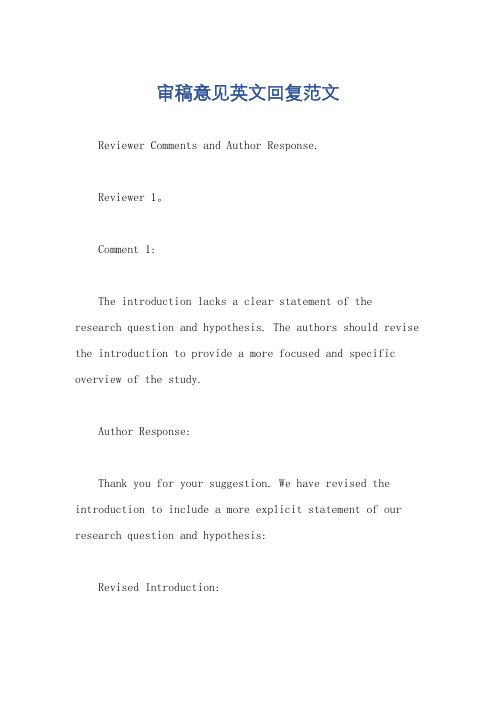
审稿意见英文回复范文Reviewer Comments and Author Response.Reviewer 1。
Comment 1:The introduction lacks a clear statement of the research question and hypothesis. The authors should revise the introduction to provide a more focused and specific overview of the study.Author Response:Thank you for your suggestion. We have revised the introduction to include a more explicit statement of our research question and hypothesis:Revised Introduction:In this study, we investigate the relationship between sleep quality and academic performance in university students. Previous research has shown that sleep deprivation can have a negative impact on cognitive function, including attention, memory, and problem-solving skills (e.g., Pilcher & Walters, 2010). However, the majority of this research has focused on children and adolescents. There is a lack of research on therelationship between sleep quality and academic performance in university students.The purpose of this study is to examine therelationship between sleep quality and academic performance in university students. We hypothesize that there will be a negative correlation between sleep quality and academic performance, such that students who report better sleep quality will have higher GPAs.Comment 2:The methods section is not sufficiently detailed. The authors should provide more information about theparticipants, the measures used, and the procedures followed.Author Response:Thank you for your feedback. We have revised the methods section to provide more detail:Revised Methods:Participants.Participants were 100 university students (50 male, 50 female) who were recruited from a large public universityin the southeastern United States. Participants wereeligible for the study if they were at least 18 years old and currently enrolled in at least one college-level course.Measures.Sleep quality was assessed using the Pittsburgh Sleep Quality Index (PSQI), a self-report questionnaire thatmeasures sleep quality over the past month. The PSQI has been shown to be a reliable and valid measure of sleep quality in university students (e.g., Buysse et al., 1989).Academic performance was assessed using students' self-reported GPAs. Students were asked to report their current GPA on a scale from 0.0 to 4.0.Procedures.Participants were recruited for the study through online advertisements and flyers posted around campus. Interested participants were screened for eligibility and then completed the PSQI and the GPA questionnaire online.Comment 3:The results section is difficult to follow. The authors should reorganize the results and present them in a more logical manner.Author Response:Thank you for your suggestion. We have reorganized the results section to make it more logical and easier to follow:Revised Results:The mean PSQI score for the sample was 6.5 (SD = 3.2), which indicates that the participants had relatively good sleep quality. The mean GPA for the sample was 3.2 (SD =0.5).There was a significant negative correlation between sleep quality and academic performance, such that students who reported better sleep quality had higher GPAs (r = -.25, p < .05). This relationship was consistent across genderand year in school.Comment 4:The discussion section does not adequately discuss the implications of the findings. The authors should expand thediscussion to include a more in-depth discussion of the implications of the findings for students, educators, and policymakers.Author Response:Thank you for your feedback. We have expanded the discussion section to include a more in-depth discussion of the implications of the findings:Revised Discussion:The findings of this study have several implicationsfor students, educators, and policymakers. First, the findings suggest that sleep quality is an important factor in academic performance. Students who get better sleep are more likely to have higher GPAs. This suggests that students should make an effort to get enough sleep, even when they are busy with schoolwork.Second, the findings suggest that educators can play a role in promoting sleep quality among their students. Forexample, educators can encourage students to establish regular sleep schedules, create a relaxing bedtime routine, and avoid caffeine and alcohol before bed.Third, the findings suggest that policymakers should consider the importance of sleep quality when making decisions about educational policies. For example, policymakers could consider implementing policies that allow students to get more sleep, such as later schoolstart times or more flexible class schedules.Reviewer 2。
这样写英文Email,对方会感觉你很有礼貌,很有风度,很想帮助你
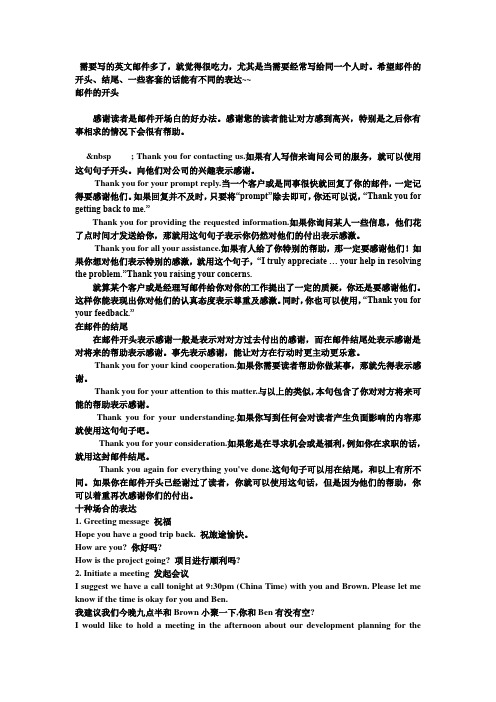
需要写的英文邮件多了,就觉得很吃力,尤其是当需要经常写给同一个人时。
希望邮件的开头、结尾、一些客套的话能有不同的表达~~邮件的开头感谢读者是邮件开场白的好办法。
感谢您的读者能让对方感到高兴,特别是之后你有事相求的情况下会很有帮助。
Thank you for contacting us.如果有人写信来询问公司的服务,就可以使用这句句子开头。
向他们对公司的兴趣表示感谢。
Thank you for your prompt reply.当一个客户或是同事很快就回复了你的邮件,一定记得要感谢他们。
如果回复并不及时,只要将“prompt”除去即可,你还可以说,“Thank you for getting back to me.”Thank you for providing the requested information.如果你询问某人一些信息,他们花了点时间才发送给你,那就用这句句子表示你仍然对他们的付出表示感激。
Thank you for all your assistance.如果有人给了你特别的帮助,那一定要感谢他们!如果你想对他们表示特别的感激,就用这个句子,“I truly appreciate … your help in resolving the problem.”Thank you raising your concerns.就算某个客户或是经理写邮件给你对你的工作提出了一定的质疑,你还是要感谢他们。
这样你能表现出你对他们的认真态度表示尊重及感激。
同时,你也可以使用,“Thank you for your feedback.”在邮件的结尾在邮件开头表示感谢一般是表示对对方过去付出的感谢,而在邮件结尾处表示感谢是对将来的帮助表示感谢。
事先表示感谢,能让对方在行动时更主动更乐意。
Thank you for your kind cooperation.如果你需要读者帮助你做某事,那就先得表示感谢。
SCI回复审稿人的回信技巧

SCI答复审稿人的回信技巧一篇稿子从酝酿到成型历经艰辛,投出去之后又是漫长的等待,好容易收到编辑的回信,得到的往往又是审稿人不留情面的一顿狂批。
这时候,如何有策略有技巧的回复审稿人就显得尤为重要。
好的回复是文章被接收的重要砝码,而不恰当的回复轻则导致再次修改从而拖延发稿时间,重则导致文章被拒,前功尽弃。
下面把我平时总结的一些答复审稿人的策略和写回复信的格式和技巧跟大家交流一下。
首先,绝对服从编辑的意见。
在审稿人给出各自的意见之后,编辑一般不会再提出自己的意见。
但是,编辑一旦提出某些意见,就意味着他认为这是文章里的重大缺陷,至少是不合他的口味。
这时,我们唯一能够做的只能是服从。
因为毕竟是人家掌握着生杀予夺的大权。
第二,永远不要跟审稿人争执。
跟审稿人起争执是非常不明智的一件事情。
审稿人意见如果正确那就不用说了,直接照办就是。
如果不正确的话,也大可不必在回复中冷嘲热讽,心平气和的说明白就是了。
大家都是青年人,血气方刚,被人拍了当然不爽,被人错拍了就更不爽了。
尤其是一些名门正派里的弟子,看到一审结果是major而不是minor本来就已经很不爽了,难得抓住审稿人的尾巴,恨不得拖出来打死。
有次审稿,一个审稿人给的意见是增加两篇参考文献(估计也就是审稿人自己的文章啦),结果作者在回复中写到,making a reference is not charity!看到之后我当时就笑喷了,可以想象审稿人得被噎成什么样。
正如大家所想的那样,这篇稿子理所当然的被拒了,虽然后来经编辑调解改成了major revision,但毕竟耽误的是作者自己的时间不是第三,合理掌握修改和argue的分寸。
所谓修改就是对文章内容进行的修改和补充,所谓argue就是在回复信中对审稿人的答复。
这其中大有文章可做,中心思想就是容易改的照改,不容易改的或者不想改的跟审稿人argue。
对于语法、拼写错误、某些词汇的更换、对某些公式和图表做进一步解释等相对容易做到的修改,一定要一毫不差的根据审稿意见照做。
用英文巧妙回复SCI期刊编辑信件

用英文巧妙回复S C I期刊编辑信件Modified by JACK on the afternoon of December 26, 2020用英文巧妙回复SCI期刊编辑信件众所周知,外审专家对于文章的主要批评意见是非常重要的,因此作者对于这些意见的回复也是尤为关键。
本文就如何用英文就其意见进行回复做一下简单说明:1、In reply to the referee’s main criticism of paper, it is possible to say that您的回复:外审专家对于表1中xxx所提出的问题现已改正。
而后面的一些小改动则不会影响文章对结果的解释。
One minor point raised by the referee concerns of the extra composition of the reaction mixture in Figure 1 has now been corrected. Further minor changes had been made on page 3,paragraph1(line 3-8)and 2(line 6-11).These do not affect our interpretation of the result. 2、我非常仔细地阅读了外审专家的意见,而且我认为文章仅仅因为缺少xxx而被拒绝刊登的。
我承认本应在丈中包含XXX 然后这仅是出于对文章简洁的考量,没有提供相关数据而非疏忽。
I have read the referee’scomments very carefully and conclude that the paper has been rejected on the sole grounds that it lacked toxicity data. I admit that l did not include a toxicity table in my article although perhaps I should have done. This was for the sake of brevity rather than an error or omission.3、谢谢您对于我文章“XXX”的回复以及外审专家的意见。
reply和reply to的用法

reply和reply to的用法
"reply"和"reply to"这两个短语的使用方式非常相似。
它们都表
示回复或回应某个人的提问、请求或消息。
它们之间的主要区别在于在某些情况下"to"是必需的。
1. "reply"的基本用法是指对某人的提问或请求进行回复。
例如:- She replied to my email promptly.(她迅速回复了我的电子邮件。
)
- I replied to his question in the meeting.(我在会议上回答了他
的问题。
)
2. "reply to"的使用方式更具体一些,它通常放在"reply"后面,
用来指明回复对象。
例如:
- She replied to my email with some additional information.(她以一些额外的信息回复了我的电子邮件。
)
- He never replies to my texts.(他从不回复我的短信。
)
总的来说,"reply"和"reply to"的含义和用法非常相似,都表示
回复或回应某个人的提问、请求或消息。
但是在需要明确回复对象时,"reply to"更常用。
审稿意见英文回复范文
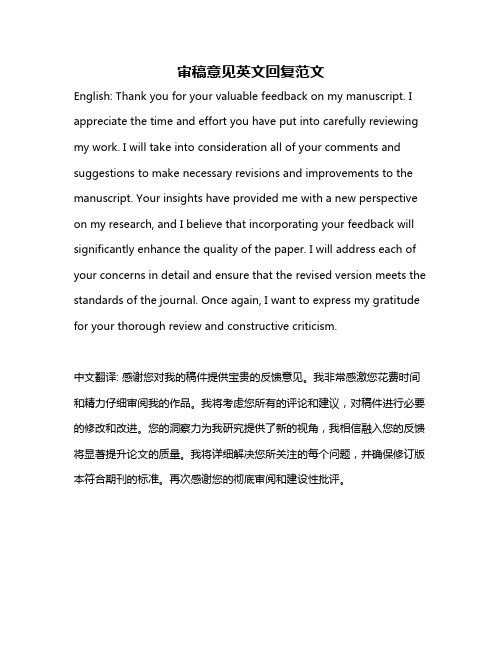
审稿意见英文回复范文English: Thank you for your valuable feedback on my manuscript. I appreciate the time and effort you have put into carefully reviewing my work. I will take into consideration all of your comments and suggestions to make necessary revisions and improvements to the manuscript. Your insights have provided me with a new perspective on my research, and I believe that incorporating your feedback will significantly enhance the quality of the paper. I will address each of your concerns in detail and ensure that the revised version meets the standards of the journal. Once again, I want to express my gratitude for your thorough review and constructive criticism.中文翻译: 感谢您对我的稿件提供宝贵的反馈意见。
我非常感激您花费时间和精力仔细审阅我的作品。
我将考虑您所有的评论和建议,对稿件进行必要的修改和改进。
您的洞察力为我研究提供了新的视角,我相信融入您的反馈将显著提升论文的质量。
我将详细解决您所关注的每个问题,并确保修订版本符合期刊的标准。
author's reply to the review report
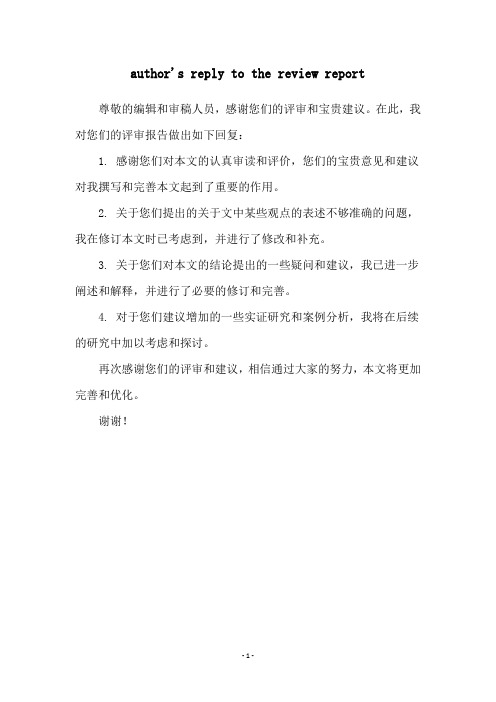
author's reply to the review report 尊敬的编辑和审稿人员,感谢您们的评审和宝贵建议。
在此,我对您们的评审报告做出如下回复:
1. 感谢您们对本文的认真审读和评价,您们的宝贵意见和建议对我撰写和完善本文起到了重要的作用。
2. 关于您们提出的关于文中某些观点的表述不够准确的问题,我在修订本文时已考虑到,并进行了修改和补充。
3. 关于您们对本文的结论提出的一些疑问和建议,我已进一步阐述和解释,并进行了必要的修订和完善。
4. 对于您们建议增加的一些实证研究和案例分析,我将在后续的研究中加以考虑和探讨。
再次感谢您们的评审和建议,相信通过大家的努力,本文将更加完善和优化。
谢谢!
- 1 -。
给国外教授发邮件会用到的礼貌用语之欧阳音创编

给国外教授发邮件会用到的礼貌用语1. I am writing to confirm /enquire/inform you...我写信时要确认/询问/通知你。
2. I am writing to follow up on our earlier decision on the marketing campaign in Q2.我写信来追踪我们之前对于第二季度营销活动的决定。
3. With reference to our telephone conversation today...关于我们今天在电话中的谈话。
4. In my previous e-mail on October5...先前在10月5日所写的信。
5. As I mentioned earlier about...如我先前所提及关于。
6. as indicated in my previous e-mail...如我在先前的信中所提出。
7. As we discussed on the phone...如我们上次在电话中的讨论。
8. from our decision at the previous meeting...如我们在上次会议中的决定。
9. as you requested/per your requirement...按照你的要求。
10.In reply to your e-mail dated April 1,we decided...回答你在4月1日写的信,我们决定。
11.This is in response to your e-mail today.这是针对你今天早上来信的回复。
12. As mentioned before, we deem this product has strong unique selling points in china.如先前所述,我们认为这个产品在中国有强有力且独一无二的销售点。
SCI论文写作全攻略——修回与退稿(转载)

SCI论文写作全攻略——修回与退稿(转载)一、正确对待审稿意见和退稿:国际核心刊物的审稿人大多是各领域权威学者,杂志出版社经常征询编委意见,选择最佳审稿队伍。
审稿是无报酬的,审稿人的工作态度大多极其认真。
因此,对审稿意见要十分尊重,对每一条批评和建议,都要认真分析,并据此修改论文。
自己认为不正确的意见,要极其慎重和认真地回答,有理有据地与审稿人探讨。
如何对待杂志拒文,是作者犯难的问题。
这里必须分析被拒绝的理由。
第一类拒绝是“完全的拒绝”,主编通常会表达个意见,对这类文章永远不愿再看到,再寄送这类文章是没有意义的;第二是文章包含某些有用数据和信息,主编拒绝是因数据或分析有严重缺陷,这类文章不妨先放一放,等找到更广泛的证据支持或有了更明晰的结论后,再将经过修改的“新”文章寄给同一杂志,主编通常会考虑重新受理该文。
有审稿人抱怨,个别中国作者在论文被一家杂志拒绝后又原封不动地寄给另外一家杂志,而他们再次被邀请审稿并对此非常反感,论文理所当然地被拒绝。
《宇宙物理学》(The,Astrophysical,Journal)的科学主编Thomas提出:“论文被一家杂志拒绝后不经修改,又寄给另一个杂志,这是很糟的错误。
通常,审稿人做了很认真的工作指出论文的问题,并建议修改;如果作者忽视这些忠告,是对时间和努力的真正浪费;同时,寄一篇坏的文章,对作者的科学声望是严重的损害。
”影响因子不同的刊物接受论文的标准和要求差别很大。
如果被拒论文不是由于文稿中的错误,而是重要性或创新性不够,作者仔细考虑审稿人意见并认真修改文稿后,可以寄给影响因子较低的刊物。
值得注意的是,审稿人由于知识限制和某种成见,甚至学术观点不同,判断错误并建议退稿常会发生。
如何处理情况?最近某青年的论文被杂志拒绝,经反复讨论检验,判断审稿人是错误的;为了论文及时发表,我们建议作者礼貌和认真地回信给主编并指出审稿人的错误,要求主编将意见转给审稿人,然后撤回论文再做必要改进,改寄影响因子更高的杂志;结果论文立即接受,并得到很好评价。
SCI修改稿回答审稿人意见范文模板
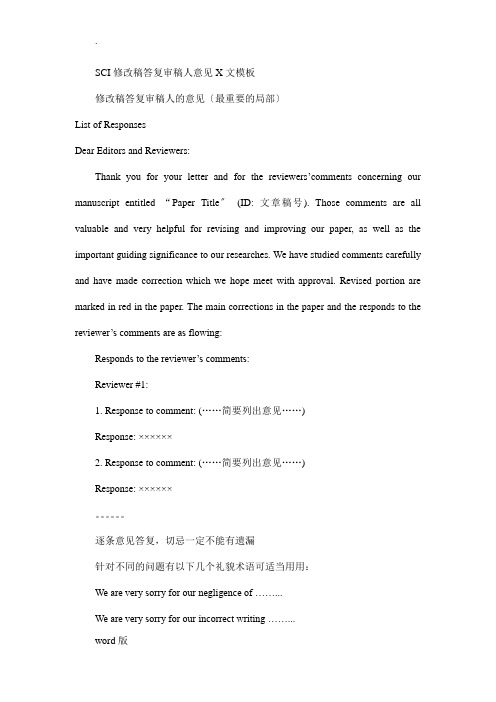
SCI修改稿答复审稿人意见X文模板修改稿答复审稿人的意见〔最重要的局部〕List of ResponsesDear Editors and Reviewers:Thank you for your letter and for the reviewers’comments concerning our manuscript entitled “Paper Title〞(ID: 文章稿号). Those comments are all valuable and very helpful for revising and improving our paper, as well as the important guiding significance to our researches. We have studied comments carefully and have made correction which we hope meet with approval. Revised portion are marked in red in the paper. The main corrections in the paper and the responds to the reviewer’s comments are as flowing:Responds to the reviewer’s comments:Reviewer #1:1. Response to comment: (……简要列出意见……)Response: ××××××2. Response to comment: (……简要列出意见……)Response: ××××××。
逐条意见答复,切忌一定不能有遗漏针对不同的问题有以下几个礼貌术语可适当用用:We are very sorry for our negligence of ……...We are very sorry for our incorrect writing ……...It is really true as Reviewer suggested that……We have made correction according to the Reviewer’s comments.We have re-written thi s part according to the Reviewer’s suggestionAs Reviewer suggested that……Considering the Reviewer’s suggestion, we have ……最后特意感谢一下这个审稿人的意见:Special thanks to you for your good comments.Reviewer #2:同上述Reviewer #3:××××××Other changes:1. Line 60-61, the statements of “……〞were corrected as “…………〞2. Line 107, “……〞was added3. Line 129, “……〞was deleted××××××We tried our best to improve the manuscript and made some changes in the manuscript. These changes will not influence the content and framework of the paper. And here we did not list the changes but marked in red in revised paper.We appreciate for Editors/Reviewers’ warm work earnestly, and hope that the correction will meet with approval.Once again, thank you very much for your comments and suggestions以下是审稿人意见和本人的回复。
- 1、下载文档前请自行甄别文档内容的完整性,平台不提供额外的编辑、内容补充、找答案等附加服务。
- 2、"仅部分预览"的文档,不可在线预览部分如存在完整性等问题,可反馈申请退款(可完整预览的文档不适用该条件!)。
- 3、如文档侵犯您的权益,请联系客服反馈,我们会尽快为您处理(人工客服工作时间:9:00-18:30)。
a r X i v :c o n d -m a t /9710205v 1 [c o n d -m a t .m e s -h a l l ] 20 O c t 1997
Fendley,Ludwig and Saleur reply to Skorik’s com-ment:
In a series of papers [1],we have used a novel approach,combining the Bethe ansatz with a kinetic (Boltzmann)equation,in order to compute exactly transport proper-ties in a Luttinger liquid with an impurity (also known as the boundary sine-Gordon model [BSGM]).In a recent comment [2],Skorik claimed that while our results were correct in linear response,there was a “serious flaw”in our calculation at finite voltage.We explain here why Skorik’s arguments are inappropriate,and that there is no flaw in our work.
In our approach,the effect of the voltage corresponds to injecting into the sample left movers and right movers from different reservoirs,at chemical potentials,µL,R =±eV
transport properties through the impurity,the effect of the voltage is to shift the Fermi sea but does not interfere with the one-by-one scattering offthe impurity (this is actually one of the basic ideas underlying the Landauer-B¨u ttiker approach).
In fact,it is also possible to diagonalize the BSGM with a voltage,and to confirm this
physical
argument
[11,8,7,12].
The main idea is to
observe
that
the phys-
ical
properties of the
BSGM are the same as the prop-erties of another model,where the boundary interaction cos φis replaced by another interaction of the Kondo type S +e −iφ+S −e iφ,where the spin is taken in,either a cyclic representation of the U q sl (2)algebra [13],or a represen-tation of the oscillator algebra [12].The key property of these representations is that all monomials (of total vanishing charge)in S ±have the same trace.One can then compare the perturbative computations of proper-ties like the partition function,or the conductance us-ing the Keldysh formalism [14]in the two models,and prove their equivalence (this method is used in [15]in the case g =1
2
case
[15]).Scattering eigenstates in the traditional sense can be constructed,and the Landauer-B¨u ttiker approach can then be applied to compute the current,the DC fluctua-tions [17],and some of the AC properties [8].
In conclusion,the formula proposed in [1]does not suf-fer from Skorik’s criticisms.For the reader who does not want to follow the detailed arguments presented above,we observe that our formula has passed successfully more tests than recognized in Skorik’s comment.In addition to the case free-fermion case g =1
[1]P.Fendley, A.Ludwig,H.Saleur,Phys.Rev.Lett.
74(1995)3005,cond-mat/9408068;75(1995)2196,cond-mat/9505031;Phys.Rev.B 52(1995)8934,cond-mat/9503172.
[2]S.Skorik,cond-mat/9708163
[3]C.Kane,M.P.A.Fisher,Phys.Rev.B 46(1992)15523;
Phys.Rev.B52(1995)17393,cond-mat/9506116.[4]A.Y.Alekseev,V.V.Cheianov,J.Fr¨o hlich,cond-mat/9607144
[5]ndauer,Phys.Rev.B47(1993)16427;M.B¨u ttiker,
Phys.Rev.B46(1992)12485.
[6]P.Fendley,H.Saleur,N.Warner,Nucl.Phys.B 430
(1994)577,hep-th/9406125
[7]F.Lesage,H.Saleur,Nucl.Phys.B 493(1997)613,cond-mat/9612050
[8]F.Lesage,H.Saleur,Nucl.Phys.B 490(1997)543,cond-mat/9611025.
[9]A.Leclair,F.Lesage,S.Sachdev,H.Saleur,Nucl.Phys.
B482(1996)579,cond-mat/9606104[10]N.Andrei,Phys.Lett.A87(1982)299.
[11]P.Fendley,F.Lesage,H.Saleur,J.Stat.Phys.85(1996)
211,cond-mat/9510055
[12]V.V.Bazhanov,S.Lukyanov,A.B.Zamolodchikov,hep-th/9604044
[13]P.Fendley,H.Saleur,Phys.Rev.Lett.75(1995)4492,
cond-mat/9506104
[14]D.Freed,C.Chamon,X.Wen,Phys.Rev.B 51(1995)
2363,cond-mat/9408064
[15]D.Freed,C.Chamon,X.Wen,Phys.Rev.B 53(1996)
4033,cond-mat/9507064
[16]V.Barzykin,I.Affleck,cond-mat/9708039
[17]P.Fendley and H.Saleur,Phys.Rev.B54(1996)10845,
cond-mat/9601117
[18]P.Fendley,M.P.A.Fisher and H.Saleur,unpublished.
[19]H.H.Lin and M.P.A.Fisher,Phys.Rev.B54(1996)
10593,cond-mat/9510156
P.Fendley1,A.W.W.Ludwig2and H.Saleur3
1Department of Physics,University of Virginia,Char-lottesville,VA22901
2Physics Department,University of California,Santa Barbara,CA93106
3Department of Physics,University of Southern Califor-nia,Los Angeles CA90089-0484。
